Middle East Digital Transformation Market Size
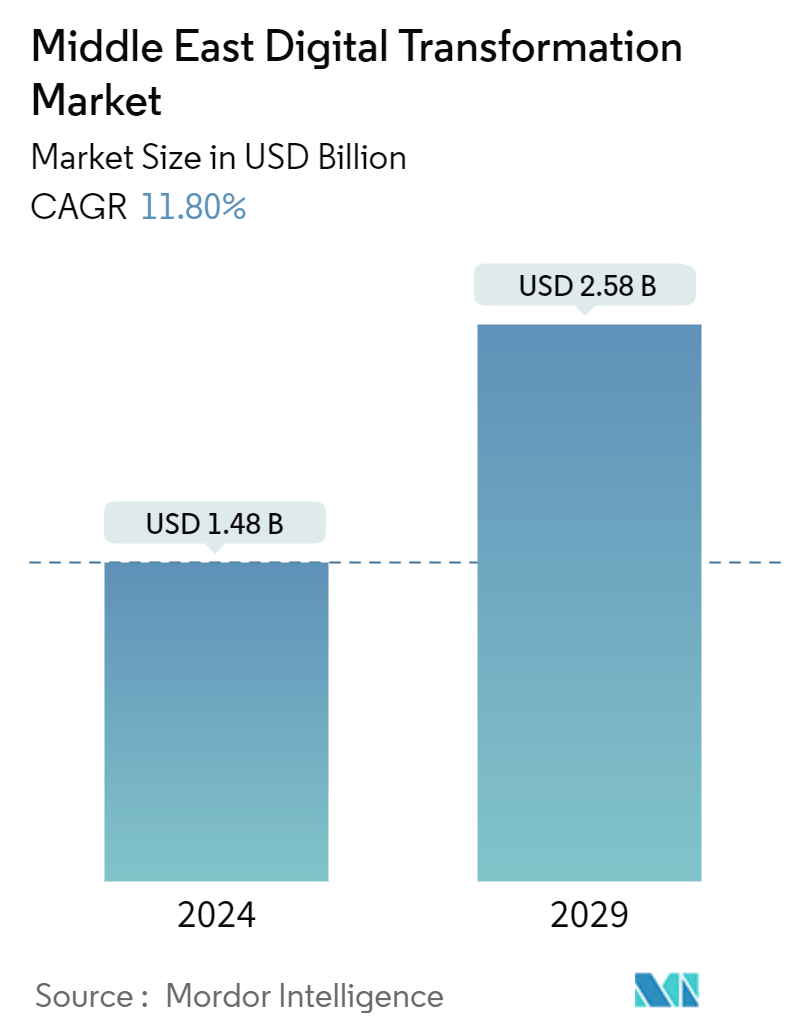
| Study Period | 2019 - 2029 |
| Base Year For Estimation | 2023 |
| Market Size (2024) | USD 1.48 Billion |
| Market Size (2029) | USD 2.58 Billion |
| CAGR (2024 - 2029) | 11.80 % |
| Market Concentration | Low |
Major Players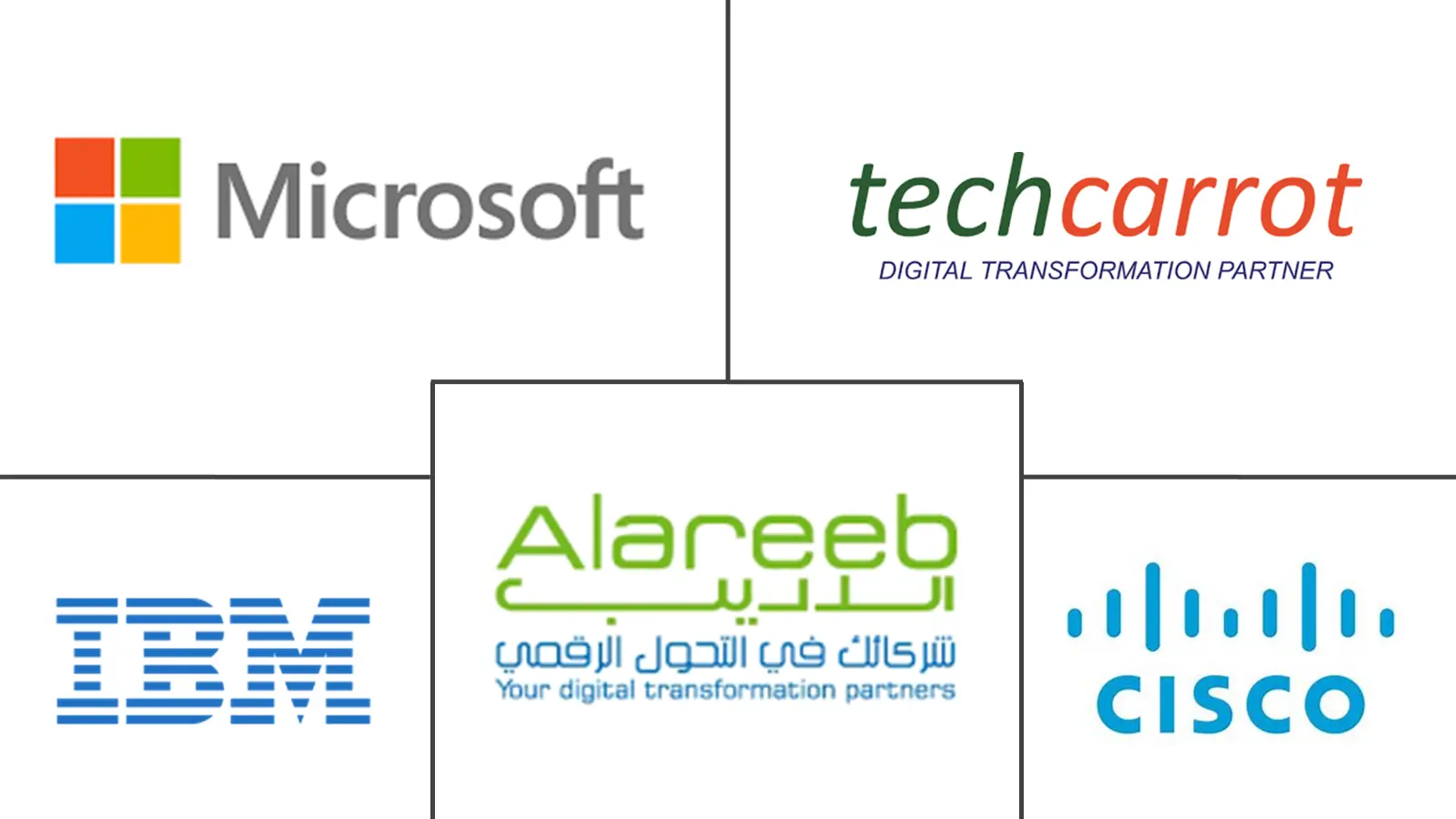
*Disclaimer: Major Players sorted in no particular order |
Middle East Digital Transformation Market Analysis
The Middle East Digital Transformation Market size is estimated at USD 1.48 billion in 2024, and is expected to reach USD 2.58 billion by 2029, growing at a CAGR of 11.80% during the forecast period (2024-2029).
- The Middle East is undergoing a rapid digital transformation driven by government initiatives, a young, tech-savvy population, and a desire for economic diversification. This shift presents a significant opportunity for businesses and investors alike.
- The advent of Industry 4.0 signifies a transformative era where billions of people are interconnected through mobile devices, harnessing advanced technologies such as artificial intelligence (AI), robotics, and nanotechnology. This revolution presents limitless possibilities for innovation and efficiency. The Middle East is actively embracing this digital transformation, positioning itself to gain substantial advantages in various sectors, including healthcare, education, and industry. By integrating these emerging technologies, the region aims to enhance productivity, drive economic growth, and improve the quality of life for its citizens.
- Several nations in the region are actively pursuing comprehensive economic diversification initiatives to lessen their dependence on oil and gas revenues. Notably, Bahrain, Saudi Arabia, and the United Arab Emirates have unveiled detailed economic blueprints emphasizing a substantial integration of advanced technologies. These strategies foster sustainable growth, enhance competitiveness, and create new job opportunities across various sectors.
- The region's manufacturing sector is experiencing significant growth, driven by population growth, urbanization, and increasing consumer demands. This expansion presents opportunities for digital transformation as manufacturers focus on enhancing productivity, quality, and operational efficiency. Thus, adopting digital technologies enables manufacturers to meet market demands.
- In Saudi Arabia and the United Arab Emirates, the governments have prioritized the development of the manufacturing sector. The United Arab Emirates has launched "Operation 300bn," a strategic initiative targeting a GDP contribution of AED 300 billion from the industrial sector by 2031. Embracing innovation, both nations, especially the United Arab Emirates, are leveraging technologies like artificial intelligence to propel their industries forward.
- Although the younger demographic often displays strong technological skills, a significant portion of the population still grapples with digital literacy. This creates a pronounced digital divide, highlighting the urgency for educational initiatives and skill-building programs.
Middle East Digital Transformation Market Trends
The IoT Segment is Expected to Occupy the Largest Market Share
- The Internet of Things (IoT) drives digital transformation by connecting physical devices and sensors to the internet, creating smart, interconnected systems. This connectivity enables real-time data collection and analysis, improving operational efficiency, supporting informed decision-making, fostering new business models, and enhancing automation across various industries.
- Most IoT adoption in the Middle East is directed toward public administration applications and smart cities. Additionally, the City planners have been using IoT networks to monitor and control infrastructure, devices, and the generated data while keeping the overall goal of optimizing public services, business opportunities, and living standards for residents intact.
- Cities like Dubai and Abu Dhabi are integrating IoT solutions into their urban infrastructure to enhance public services and elevate citizen living standards. Dubai, in particular, is at the forefront with its ambitious Smart City initiative, utilizing IoT for various applications, including traffic management and environmental monitoring.
- This project is expected to redefine smart living per the national economic development objectives of Egypt Vision 2030. Etisalat is expected to deliver innovative, connected technologies to improve the new capital's safety, security, and energy efficiency and deliver long-term benefits to its population.
- According to GSMA Intelligence, by 2025, the enterprise sector in the Middle East and North Africa (MENA) is projected to have around 529 million Internet of Things (IoT) connections, with the consumer sector following closely at 503 million. Nearly half of the region's mobile internet connections are anticipated to utilize 4G technology by the same year.
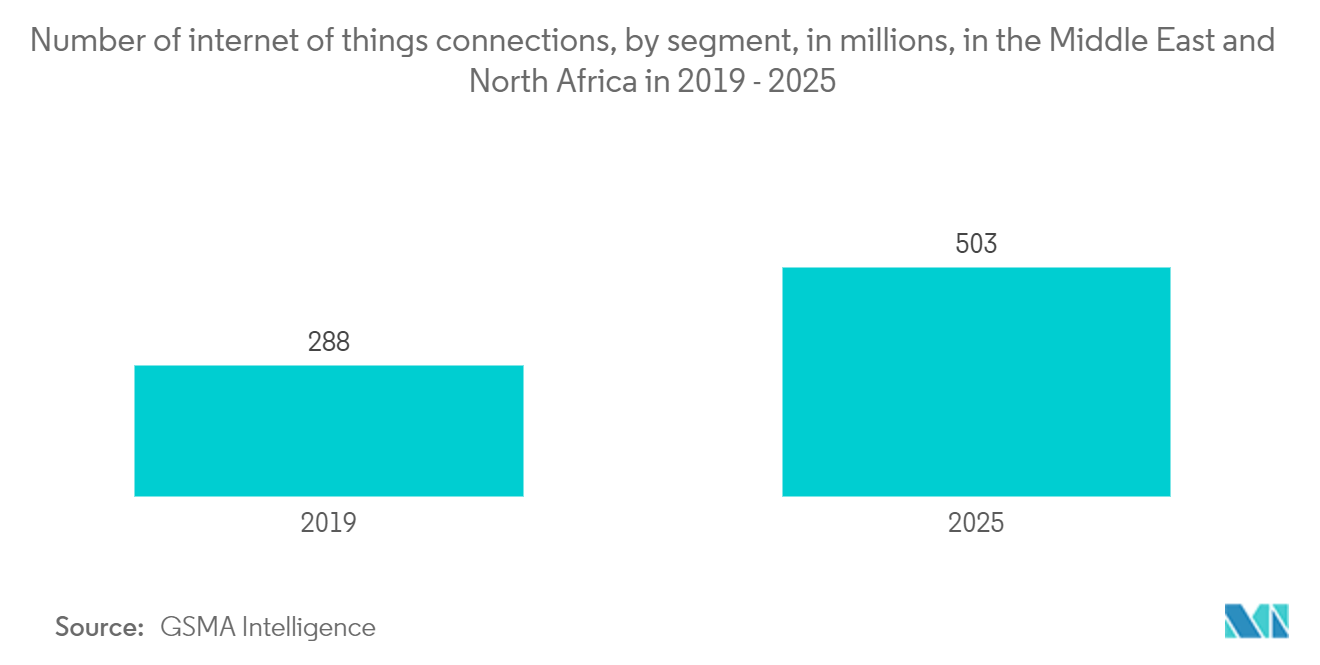
Saudi Arabia is Expected to be the Fastest Growing Market
- Saudi Arabia is on the verge of a transformative era filled with vast growth potential and endless opportunities. As digitalization accelerates, the nation's strategic focus on enhancing network infrastructure, adopting 5G technology, and forming key partnerships will be crucial in achieving a more interconnected and prosperous future.
- Under Vision 2030, Saudi Arabia is actively digitalizing its industries, a pivotal initiative already gaining momentum. Leveraging 5G technology, particularly artificial intelligence (AI), stands central to this transformation. The nation is fostering AI adoption by developing AI-centric environments, backing data analytics solutions, and spearheading grand projects like NEOM, a futuristic smart city.
- Aligned with its Vision 2030 strategy, the Saudi government initiated multiple projects to bolster digital transformation in the Western region. Initiatives such as the National Digital Transformation Program (NDTP) aim to enhance e-commerce, digitalize public services, and foster innovation ecosystems, particularly in Mecca and Jeddah.
- Saudi Arabia achieved a score of 76.99 in the 2023 IMD World Digital Competitiveness Rankings, which assess economies from the most to the least competitive, with scores ranging from 0 to 100. Several cities in Saudi Arabia are featured in the IMD Smart City Index, contributing to market growth. The Saudi Vision 2030 agenda includes smart city development, enhancing cloud infrastructure, and promoting IoT technology.
- In March 2024, Amazon Web Services (AWS) announced its plans to establish an AWS infrastructure Region in Saudi Arabia by 2026. This move is poised to provide a strategic advantage to developers, startups, enterprises, and various sectors, including healthcare, education, gaming, and nonprofits. These entities may cater to end-users while ensuring data residency compliance by hosting their applications in data centers within Saudi Arabia. Highlighting its commitment, AWS has invested over USD 5.3 billion (approximately SAR 19.88 billion) in Saudi Arabia.
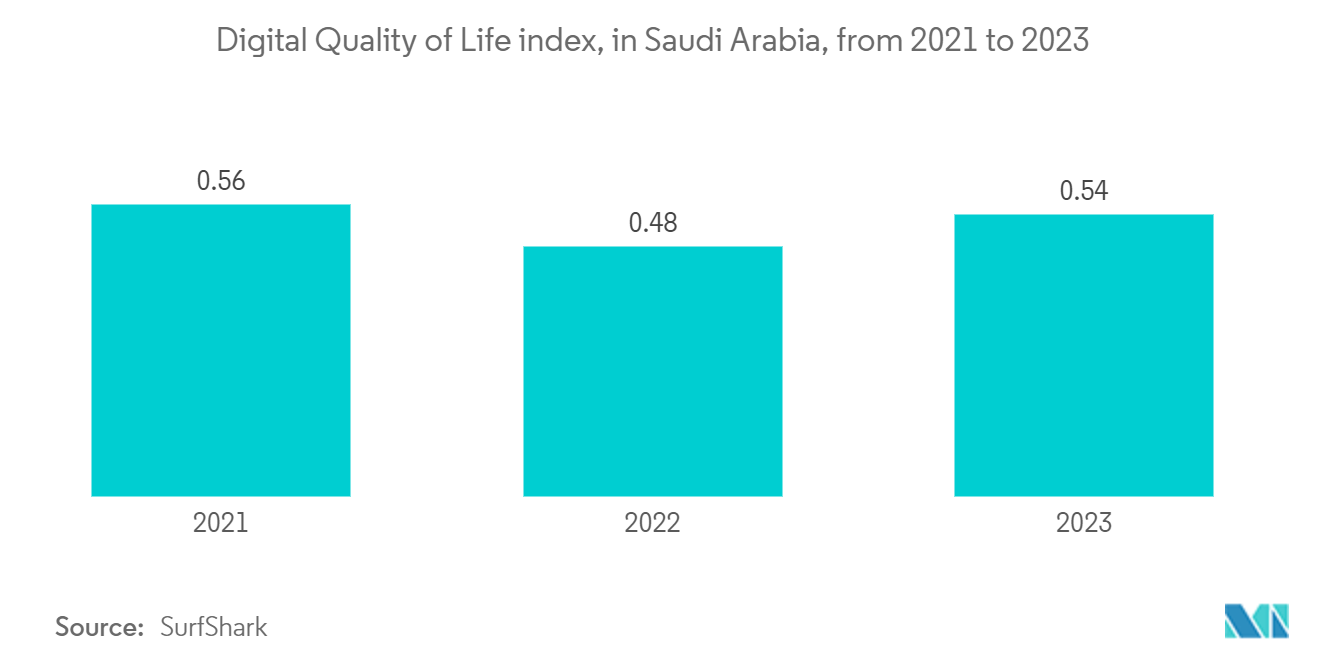
Middle East Digital Transformation Industry Overview
The Middle Eastern digital transformation market is highly fragmented due to the presence of many players. Several key players are constantly striving to make advancements. A few prominent companies enter collaborations and expand their footprints in developing regions to consolidate their positions. IBM Corporation, Microsoft Corporation, Alareeb, and others are some of the major players in the market.
- In April 2024, Informatica, a player in enterprise cloud data management, unveiled its AI-driven Intelligent Data Management Cloud (IDMC) in Saudi Arabia, marking a significant milestone for the nation. This strategic move involved the establishment of a new Point of Delivery (PoD) in Riyadh, showcasing Informatica's dedication to bolstering local, scalable, cloud-centric data management services. The initiative aligns closely with the Saudi government's Vision 2030, aimed at digitally transforming all sectors of the economy.
- In February 2024, STC Group, a prominent digital facilitator in the MENA region based in Saudi Arabia, recently inked a memorandum of understanding (MoU) with iBASIS. iBASIS, known for its communication solutions, catered to operators and digital entities on a global scale. The agreement, formalized at the Capacity Middle East event in Dubai last week, is laser-focused on enhancing the regional communication landscape through IoT technology.
Middle East Digital Transformation Market Leaders
-
Cisco Systems, Inc.
-
IBM Corporation
-
Microsoft Corporation
-
techcarrot FZ LLC
-
Alareeb ICT
*Disclaimer: Major Players sorted in no particular order
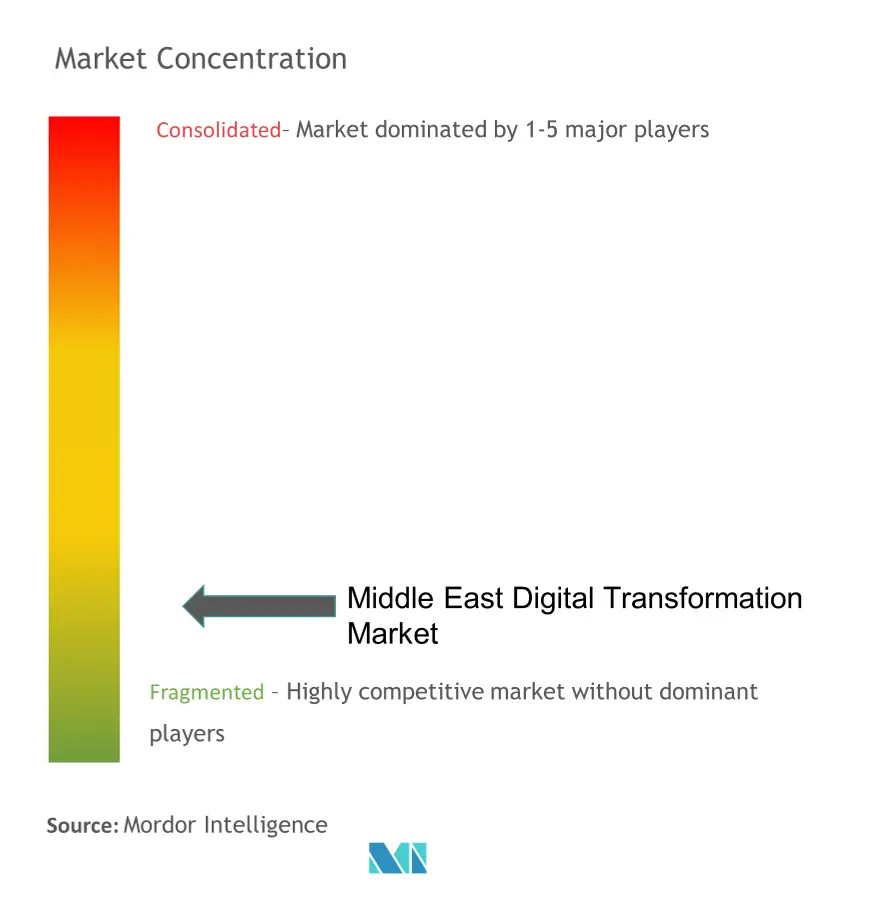
Middle East Digital Transformation Market News
- May 2024: Aramco and Qualcomm signed an MoU to accelerate the advancement of industrial 4G, 5G, and non-terrestrial networks (NTN) in Saudi Arabia. The collaboration between the chip giant and the state-owned Aramco would focus on leveraging 450 MHz cellular technology. The partnership aims to develop the requisite hardware, software, and services for deploying comprehensive IoT solutions tailored for industrial and enterprise applications.
- April 2024: G42, a UAE-based artificial intelligence (AI) technology holding company, partnered with Microsoft Corp. Microsoft invested USD 1.5 billion in G42. This investment is set to deepen the collaboration between the two entities, focusing on deploying advanced Microsoft AI technologies and upskilling initiatives in the United Arab Emirates.
Middle East Digital Transformation Market Report - Table of Contents
1. INTRODUCTION
- 1.1 Study Assumptions and Market Definition
- 1.2 Scope of the Study
2. RESEARCH METHODOLOGY
3. EXECUTIVE SUMMARY
4. MARKET INSIGHTS
- 4.1 Market Overview
-
4.2 Industry Attractiveness - Porter's Five Forces Analysis
- 4.2.1 Bargaining Power of Suppliers
- 4.2.2 Bargaining Power of Consumers
- 4.2.3 Threat of New Entrants
- 4.2.4 Threat of Substitute Products
- 4.2.5 Intensity of Competitive Rivalry
- 4.3 Industry Ecosystem Analysis (Detailed Coverage of Key Stakeholders in Digital Transformation Industry Product/Solution Providers, System Integrators/VARs, Connectivity Providers, Regulatory Bodies, End-users, Service Providers, etc.)
5. MARKET DYNAMICS
-
5.1 Market Drivers
- 5.1.1 Increase in the adoption of big data analytics and other technologies in the region
- 5.1.2 The rapid proliferation of mobile devices and apps
-
5.2 Market Restraints
- 5.2.1 Concerns about the Privacy and Security of Information
6. CURRENT MARKET SCENARIO AND EVOLUTION OF DIGITAL TRANSFORMATION PRACTICES
7. KEY METRICS
- 7.1 Technology Spending Trends
- 7.2 Number of IoT Devices
- 7.3 Total Cyberattacks
- 7.4 Technology Staffing Trends
- 7.5 Internet growth and penetration in the region
- 7.6 Digital Competitiveness Ranking
- 7.7 fixed and mobile broadband coverage
- 7.8 Cloud adoption
- 7.9 AI adoption
- 7.10 E-commerce penetration
8. MARKET SEGMENTATION
-
8.1 By Type
- 8.1.1 Artificial Intelligence and Machine Learning
- 8.1.1.1 Current Market Scenario and Market Projections for the Forecast Period
- 8.1.1.2 Key Growth Influencers (Drivers, Challenges, and Opportunities)
- 8.1.1.3 Use Case Analysis
- 8.1.1.4 Market Outlook
- 8.1.2 Extended Reality (VR and AR)
- 8.1.2.1 Current Market Scenario and Market Projections for the Forecast Period
- 8.1.2.2 Key Growth Influencers (Drivers, Challenges, and Opportunities)
- 8.1.2.3 Use Case Analysis
- 8.1.2.4 Market Outlook
- 8.1.3 IoT
- 8.1.3.1 Current Market Scenario and Market Projections for the Forecast Period
- 8.1.3.2 Key Growth Influencers (Drivers, Challenges, and Opportunities)
- 8.1.3.3 Use Case Analysis
- 8.1.3.4 Market Outlook
- 8.1.4 Industrial Robotics
- 8.1.4.1 Current Market Scenario and Market Projections for the Forecast Period
- 8.1.4.2 Key Growth Influencers (Drivers, Challenges, and Opportunities)
- 8.1.4.3 Use Case Analysis
- 8.1.4.4 Market Outlook
- 8.1.5 Blockchain
- 8.1.5.1 Current Market Scenario and Market Projections for the Forecast Period
- 8.1.5.2 Key Growth Influencers (Drivers, Challenges, and Opportunities)
- 8.1.5.3 Use Case Analysis
- 8.1.5.4 Market Outlook
- 8.1.6 Digital Twin
- 8.1.6.1 Current Market Scenario and Market Projections for the Forecast Period
- 8.1.6.2 Key Growth Influencers (Drivers, Challenges, and Opportunities)
- 8.1.6.3 Use Case Analysis
- 8.1.6.4 Market Outlook
- 8.1.7 Additive Manufacturing
- 8.1.7.1 Current Market Scenario and Market Projections for the Forecast Period
- 8.1.7.2 Key Growth Influencers (Drivers, Challenges, and Opportunities)
- 8.1.7.3 Use Case Analysis
- 8.1.7.4 Market Outlook
- 8.1.8 Cybersecurity
- 8.1.8.1 Current Market Scenario and Market Projections for the Forecast Period
- 8.1.8.2 Key Growth Influencers (Drivers, Challenges, and Opportunities)
- 8.1.8.3 Use Case Analysis
- 8.1.8.4 Market Outlook
- 8.1.9 Cloud Edge Computing
- 8.1.9.1 Current Market Scenario and Market Projections for the Forecast Period
- 8.1.9.2 Key Growth Influencers (Drivers, Challenges, and Opportunities)
- 8.1.9.3 Use Case Analysis
- 8.1.9.4 Market Outlook
- 8.1.10 Other Cloud Edge Computing (Digital Twin, Mobility, and Connectivity)
- 8.1.10.1 Current Market Scenario and Market Projections for the Forecast Period
- 8.1.10.2 Key Growth Influencers (Drivers, Challenges, and Opportunities)
- 8.1.10.3 Use Case Analysis
- 8.1.10.4 Market Outlook
-
8.2 By End-user Industry
- 8.2.1 Manufacturing
- 8.2.2 Oil, Gas, and Utilities
- 8.2.3 Retail and E-commerce
- 8.2.4 Transportation and Logistics
- 8.2.5 Healthcare
- 8.2.6 BFSI
- 8.2.7 Telecom and IT
- 8.2.8 Government and Public Sector
- 8.2.9 Other End-user Industries (Education, Media and Entertainment, Environment, etc.)
-
8.3 By Country***
- 8.3.1 Saudi Arabia
- 8.3.2 United Arab Emirates
- 8.3.3 Qatar
- 8.3.4 Egypt
- 8.3.5 Israel
- 8.3.6 Kuwait
- 8.3.7 Bahrain
- 8.3.8 Iran
9. COMPETITIVE LANDSCAPE
-
9.1 Company Profiles
- 9.1.1 Cisco Systems Inc.
- 9.1.2 IBM Corporation
- 9.1.3 Microsoft Corporation
- 9.1.4 techcarrot FZ LLC
- 9.1.5 Alareeb ICT
- 9.1.6 Baariz
- 9.1.7 Oracle Corporation
- 9.1.8 SAP SE
- 9.1.9 Accenture PLC
- 9.1.10 Ernst & Young (E&Y)
- 9.1.11 Siemens AG
- *List Not Exhaustive
10. KEY TRANSFORMATIVE TECHNOLOGIES
- 10.1 Quantum Computing
- 10.2 Manufacturing as a Service (MaaS)
- 10.3 Cognitive Process Automation
- 10.4 Nanotechnology
Middle East Digital Transformation Industry Segmentation
Digital transformation is the process of incorporating digital technologies such as artificial intelligence and machine learning, extended reality (VR and AR) for industrial applications, IoT, industrial robotics, blockchain, digital twin, 3D printing/ additive manufacturing, industrial cyber security, wireless connectivity, edge computing, smart mobility, and others across various end-user industries.
The Middle Eastern digital transformation market is segmented by type (artificial intelligence and machine learning, extended reality (VR and AR) for industrial applications, IoT, industrial robotics, blockchain, digital twin, additive manufacturing, industrial cyber security, wireless connectivity, industrial 3D printing market, edge computing, and smart mobility), end-user industry (manufacturing, oil, gas, and utilities, retail and e-commerce, transportation and logistics, healthcare, BFSI, telecom and IT, government and public sector, and other end-user industries) and country (Saudi Arabia, Qatar, United Arab Emirates, Egypt, Israel, Kuwait, Bahrain, Iran, and Rest of Middle East). The report offers the market size in value terms in USD for all the abovementioned segments.
| By Type | Artificial Intelligence and Machine Learning | Current Market Scenario and Market Projections for the Forecast Period |
| Key Growth Influencers (Drivers, Challenges, and Opportunities) | ||
| Use Case Analysis | ||
| Market Outlook | ||
| By Type | Extended Reality (VR and AR) | Current Market Scenario and Market Projections for the Forecast Period |
| Key Growth Influencers (Drivers, Challenges, and Opportunities) | ||
| Use Case Analysis | ||
| Market Outlook | ||
| By Type | IoT | Current Market Scenario and Market Projections for the Forecast Period |
| Key Growth Influencers (Drivers, Challenges, and Opportunities) | ||
| Use Case Analysis | ||
| Market Outlook | ||
| By Type | Industrial Robotics | Current Market Scenario and Market Projections for the Forecast Period |
| Key Growth Influencers (Drivers, Challenges, and Opportunities) | ||
| Use Case Analysis | ||
| Market Outlook | ||
| By Type | Blockchain | Current Market Scenario and Market Projections for the Forecast Period |
| Key Growth Influencers (Drivers, Challenges, and Opportunities) | ||
| Use Case Analysis | ||
| Market Outlook | ||
| By Type | Digital Twin | Current Market Scenario and Market Projections for the Forecast Period |
| Key Growth Influencers (Drivers, Challenges, and Opportunities) | ||
| Use Case Analysis | ||
| Market Outlook | ||
| By Type | Additive Manufacturing | Current Market Scenario and Market Projections for the Forecast Period |
| Key Growth Influencers (Drivers, Challenges, and Opportunities) | ||
| Use Case Analysis | ||
| Market Outlook | ||
| By Type | Cybersecurity | Current Market Scenario and Market Projections for the Forecast Period |
| Key Growth Influencers (Drivers, Challenges, and Opportunities) | ||
| Use Case Analysis | ||
| Market Outlook | ||
| By Type | Cloud Edge Computing | Current Market Scenario and Market Projections for the Forecast Period |
| Key Growth Influencers (Drivers, Challenges, and Opportunities) | ||
| Use Case Analysis | ||
| Market Outlook | ||
| By Type | Other Cloud Edge Computing (Digital Twin, Mobility, and Connectivity) | Current Market Scenario and Market Projections for the Forecast Period |
| Key Growth Influencers (Drivers, Challenges, and Opportunities) | ||
| Use Case Analysis | ||
| Market Outlook | ||
| By End-user Industry | Manufacturing | |
| Oil, Gas, and Utilities | ||
| Retail and E-commerce | ||
| Transportation and Logistics | ||
| Healthcare | ||
| BFSI | ||
| Telecom and IT | ||
| Government and Public Sector | ||
| Other End-user Industries (Education, Media and Entertainment, Environment, etc.) | ||
| By Country*** | Saudi Arabia | |
| United Arab Emirates | ||
| Qatar | ||
| Egypt | ||
| Israel | ||
| Kuwait | ||
| Bahrain | ||
| Iran |
Middle East Digital Transformation Market Research FAQs
How big is the Middle East Digital Transformation Market?
The Middle East Digital Transformation Market size is expected to reach USD 1.48 billion in 2024 and grow at a CAGR of 11.80% to reach USD 2.58 billion by 2029.
What is the current Middle East Digital Transformation Market size?
In 2024, the Middle East Digital Transformation Market size is expected to reach USD 1.48 billion.
Who are the key players in Middle East Digital Transformation Market?
Cisco Systems, Inc., IBM Corporation, Microsoft Corporation, techcarrot FZ LLC and Alareeb ICT are the major companies operating in the Middle East Digital Transformation Market.
What years does this Middle East Digital Transformation Market cover, and what was the market size in 2023?
In 2023, the Middle East Digital Transformation Market size was estimated at USD 1.31 billion. The report covers the Middle East Digital Transformation Market historical market size for years: 2019, 2020, 2021, 2022 and 2023. The report also forecasts the Middle East Digital Transformation Market size for years: 2024, 2025, 2026, 2027, 2028 and 2029.
Middle East Digital Transformation Industry Report
Statistics for the 2024 Middle East Digital Transformation market share, size and revenue growth rate, created by Mordor Intelligence™ Industry Reports. Middle East Digital Transformation analysis includes a market forecast outlook for 2024 to 2029 and historical overview. Get a sample of this industry analysis as a free report PDF download.



